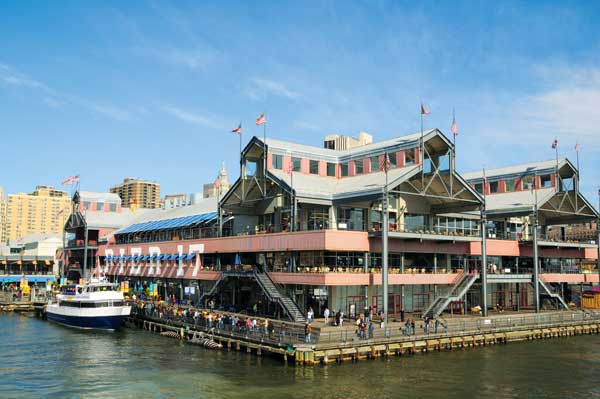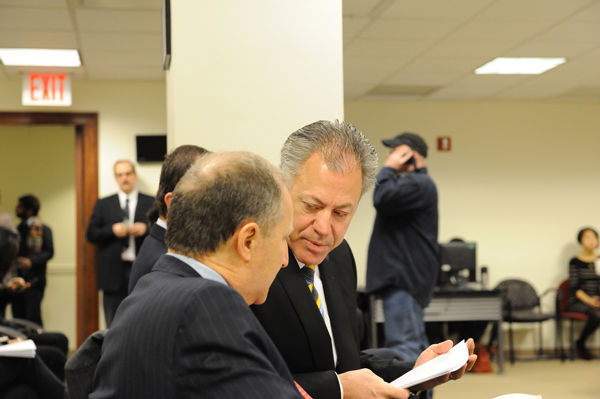
By TERESE LOEB KREUZER | Dallas-based Howard Hughes Corporation, which holds a 60-year lease on Pier 17 and some adjoining parts of the South Street Seaport, is asking City Council’s approval of its plans to demolish the mall on Pier 17 and replace it with a glass structure. The vote, scheduled for Wednesday, March 20, would be the final stage of the ULURP (Uniform Land Use Review Procedure) process mandated by the city for the disposition of city-owned property and for zoning changes, both of which are on the table here.
But some community groups and thousands of individuals who have signed a petition circulated by the Save Our Seaport Coalition are saying that much more than the mall on Pier 17 is at stake. They say that what hangs in the balance is the entire future of the Seaport, which they fear could lose its historic character and be developed into a high-rise landscape.
At a City Council hearing on March 14, so many people wanted to testify that the hearing had to be moved from a small room at 250 Broadway to City Council chambers in City Hall.
Because of the change in venue, the hearing started 90 minutes late. Many of the 200 people who wanted to speak had to leave before the four-hour hearing was over.
Most of the people who testified were opposed to Howard Hughes’ plans for Pier 17 and were wary of Howard Hughes’ intentions toward the rest of the Seaport.
A letter of intent between Howard Hughes and New York City’s Economic Development Corporation, which has jurisdiction over the Seaport, would give Howard Hughes an option to develop the sites presently occupied by the New Market and Tin Buildings in the former Fulton Fish Market on South Street.
Christopher Curry, senior executive vice president for Howard Hughes, has repeatedly denied that the company has a master plan for these sites or for the Seaport as a whole.
However, Howard Hughes has asked that the Seaport be rezoned in such a way that it could build large structures on the land adjacent to Pier 17. In addition, Hughes’ architect, Gregg Pasquarelli of SHoP Architects, designed a 500-foot hotel-condo tower at the New Market site in 2008 for the firm’s predecessor at the Seaport, General Growth Properties.
Michael Kramer, speaking for the Save Our Seaport Coalition, asked that Howard Hughes’ rezoning request for Pier 17 be either withdrawn or made subject to restrictions that would preserve the historic and public character of the Seaport historic district.
“The Howard Hughes Corporation has presented a highly disingenuous development strategy, and their public presentations to the city and to Manhattan Community Board 1 are at best inconsistent with what they are saying in their S.E.C. filings and investor solicitations,” Kramer read in a prepared statement to the Council.
“The scope of their ULURP includes both the Historic South Street Seaport District and Piers 15 and 16, and yet they cynically refuse to discuss any plans beyond Pier 17 for properties under their option or control.”
Kramer’s statement on behalf of the Seaport Coalition called Howard Hughes’ stance “dishonest and insulting to this body” “and contrary to sound master planning principles and the public process.”
The members of the Save Our Seaport Coalition include Save Our Seaport, Downtown Independent Democrats, The Historic Districts Council, Metropolitan Waterfront Alliance, Southbridge Towers, the Two Bridges Neighborhood Council and the New Amsterdam Market among other organizations and individuals.
Accompanied by architect Pasquarelli, a partner at SHoP, and attorney Paul Selver, Curry testified at the City Council hearing about Howard Hughes’ plans for the pier.
“This project increases the economic development within the city while minimizing the city risk,” he said. “Howard Hughes is preparing to spend over $200 million to complete this proposed renovation project.”
Curry said that Howard Hughes would assume the city’s current obligation to maintain the structural integrity of the pier at a cost of $18 million over the next five years. He estimated the cost of maintaining the pier over the remaining lease, which expires in 2072, at $100 million.
In his testimony, Curry stated that the Pier 17 renovation project had been approved by the New York City Planning Commission, the Landmarks Preservation Commission and Community Board 1.
C.B. 1, however, had made its approval conditional on Howard Hughes meeting certain requirements including “that the rezoning that occurs as part of this application be limited to that made necessary by the proposed project itself and that such rezoning not extend to areas such as the New Market Building and Tin Building that are not part of the proposed project.”
Jessica Lappin, a member of City Council’s Sub-Committee on Zoning and Franchises, quizzed representatives of the E.D.C. about how Howard Hughes’ ULURP request would affect the rest of the Seaport. She specifically asked about the implications for the New Amsterdam Market, which has operated a seasonal outdoor market on South Street for several years and whose founder, Robert LaValva, has said he would like to open a year-round market in the Tin and New Market Buildings.
“In terms of the [New Market and Tin] buildings, there’s no plan for the buildings right now,” said Joe Coletti, vice president of government and community relations for the E.D.C. “They’re not included in the ULURP.”
“When you say ‘no plans for them right now?’ What does that mean?” Lappin asked.
“Howard Hughes has an option on both these buildings, which means that they have the opportunity to submit plans [to the E.D.C.], but there are no plans that have been submitted yet,” said Coletti. “This is completely separate and apart from the current ULURP that we’re going through.”
Lappin sounded skeptical. “I understand,” she said. “But I wouldn’t say it’s completely separate and apart. There’s a lot going on at the Seaport and I think you should be looking at it holistically.”
She said that the action in front of City Council would affect the South Street Seaport Museum and the New Amsterdam Market.
“I hear from my constituents how much they enjoy the New Amsterdam Market – that it’s been something that has brought them down to the Seaport when there wasn’t much else pulling them to the community and to the neighborhood and I think that’s something that should be on the table and should be studied,” she said.
City Councilmember Margaret Chin, whose district includes the Seaport, interrogated Curry sharply and at length. Chin wanted to know about Howard Hughes’ retail plans for the Seaport, including how much rent would be charged.
“As much as we can charge,” Curry replied. Chin said that she had heard the rents could be as high as $300 a square foot. Curry said that was unlikely.
Chin also wanted to know about the impact of construction on existing tenants, who have been told by Howard Hughes that they must vacate Pier 17 by April 30, how noise generated by proposed concerts on the pier would be mitigated, what public access there would be under the proposed plan and to what degree the proposed plan would accommodate maritime uses of the pier.
“I want Pier 17 to be functional, not just from a retail perspective, but as a home for real, active maritime uses,” she said.
She was adamant that Pier 17’s existing tenants should be allowed to remain on the pier through the busy summer season to give them a chance to recoup the losses they suffered from Superstorm Sandy. She also said that these tenants should have an opportunity to return to the pier after construction is finished.
“We appreciate your sentiments,” Curry replied. “You’re looking out for your constituents and I’m looking out for my corporation and want to do what’s best for the whole district – not just for the tenants who are in the existing Pier 17 building.”
Howard Hughes’ plan does have some enthusiastic supporters who expressed their views at the City Council hearing. Spokespersons for construction unions said the work on the pier would provide much-needed jobs, and the Downtown Alliance’s spokesperson, Connie Chung, said “the success of Pier 17 will be a benefit to our entire business district. It will create more open space, more retail opportunities, more jobs and increased local sales tax revenue.”
On the other side of the issue, the Save Our Seaport Coalition and the New Amsterdam Market were planning to stage a rally on the steps of City Hall on Tuesday, March 19, but organizers canceled it because of the expected rain.
At the City Council hearing on March 14, LaValva said that The Howard Hughes Corporation’s letter of intent to the city would permit development of the Fulton Fish Market site as a luxury residential high rise, hotel and retail complex.
“The proposed rezoning therefore enables a development that has never been revealed to the public or reviewed by the Council. If we wait until these plans are proposed, it will be too late,” he said.
He asked that City Council vote ‘no’ on the ULURP application “until such time that E.D.C. and Howard Hughes submit their mixed use development plan for the Fulton Fish Market site to full public review.”


































